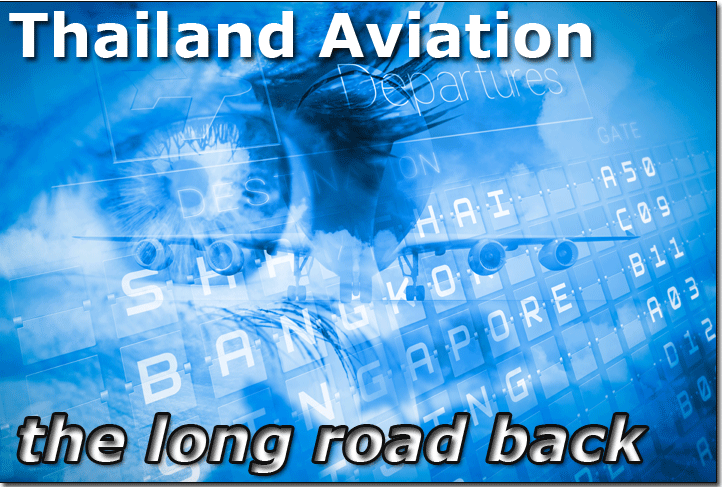
As reported
late last year by FT, the ICAO safety audit that downgraded
the Thai aviation system to Category 2 basically said
Thai commercial aviation is deficient and not up to
snuff to international minimum safety standards, a notion
later endorsed by both the US FAA and their European
counterpart EASA after conducting their own audits.
However, the downgrading
of Thailand to Category 2 in the U.S. did not affect
the Thai registered carriers all too much, as Thai Airways
(TG) had stopped serving their only U.S. destination—Los
Angeles (LAX)—in October 2015 and Bangkok Airways
(PG) operates only intra-Asian flights.
Still, the FAA’s
verdict affects the ability of TG, PG, and others to
interline and codeshare with partner airlines from the
U.S., which at least for TG is seriously draining the
already cash-strapped carrier. Thai Airways has laid
off 20 percent of its staff and grounded aircraft—including
its two 747-400 freighters—in order to cut back
expenses.
In the meantime, other
Asian countries heeding the warnings have restricted
Thai flag carriers’ abilities to change schedules,
introduce new services, change aircraft types, and operate
charter flights.
Thailand barely escaped
a serious setback, as the European air transport watchdog
EASA did not follow the FAA in downgrading the Thai
aviation system by restricting the ability of Thai carriers
to operate services to, from, and through Europe, but
merely announced that “the developments in the
Thai aviation system were monitored continuously and
that EASA would help Thailand to get their oversight
up to internationally accepted standards.”
Change
Is Coming
But as you read this,
the Thai government is taking some decisive action.
The Royal Thai Department
of Civil Aviation, DCA, has been shut down and a new
regulatory body, the Civil Aviation Authority of Thailand,
is in place, built up from scratch with qualifications
and staff performance now under review.
A team of safety and security
experts from the UK is boots on the ground in Thailand
and has been at work there since early February, providing
assistance to install nothing less than a complete overhaul
of Thailand’s aviation system.
All 41 Air Operator Certificates
(AOCs) issued by the former Thai DCA have been suspended
and are valid only on a probationary basis, subject
to reevaluation and ultimate reissuance or revocation
depending on the findings of audit teams led by the
British safety experts.
It’s a fact that
28 out of 41 airlines registered in Thailand operate
international flights, and it is understood that a crucial
point of the proceedings is the ability of the new Thai
aviation body CAAT to deal with the shortcomings surrounding
LCC carriers in particular.
Currently, the Air Traffic
Pilot Licenses of 2,350 pilots in Thailand have been
under review and reissued only where stringent international
requirements have been met and the British experts’
stringent criteria fulfilled.
So maybe a new dawn is
breaking on the Thai aviation sector’s horizon?
It
Don’t Come Easy
The main task of the British
experts has been the almost herculean task of training
their Thai counterparts to a minimum level matching
international standards.
The task is made that
much more difficult because the training work must also
include language proficiency and address some serious
shortcomings with respect to safety and security issues,
including enforcement of Dangerous Goods Regulations
in Thailand by Thai operators.
Despite progress, sources
say the training is massive and ongoing and will take
several months.
Only when a sufficient
number of Thai aviation inspectors have successfully
completed the mandated training will the inspections
of the Thai-registered airlines begin, issuing these
carriers AOC’s.
However, it looks like
that could begin this month in May 2016.
Bangkok Post reports that
the process of inspections and reissuing of both AOCs
and ATPLs for Thai carriers and pilots is hoped to be
completed before the end of 2016, although officials
cautioned that the undertaking depends largely on a
sufficient number of the CAAT’s staff to pass
their own recertifications in order to exercise the
oversight required.
That the Royal Thai government
seems serious in its commitment to step up regulatory
oversight and address the shortcomings seems a no-brainer
in terms of Thailand’s survival.
The booming tourism sector
in Thailand accounts for more than 15 percent of the
Thai GDP, according to figures from Kasikornbank Thailand.
A safer and more structured
aviation system would not only help Thailand secure
quick transportation of their important IT, perishables,
and garment trade for Thai-registered airlines employing
Thai nationals, thereby strengthening the Thai economy,
but it would also draw more tourists and stimulate the
country’s air cargo business.
Stay tuned.
Ivar
|





